This page highlights Nine Crosses that are largely undecorated. They include: Nurney and Old Leighlin (Co. Carlow) Tonaknock, Kilmalkedar, Renconnell and Killiney (Co. Kerry), Sleaty (Co. Laois) and Emly (Co. Tipperary)
The High Crosses that do not have much, if any, carving are often neglected by scholars because they lack interest symbolically. This lack of carving also increases the difficulty in dating these crosses.
In the fall of 2011 my wife and I visited a number of largely undecorated crosses. The sites are varied and each cross has a character of its own. Here are a few of these crosses.
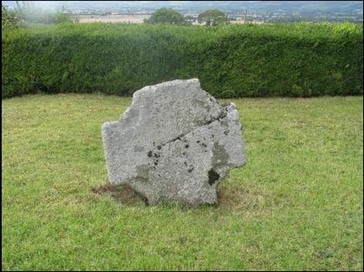
Nurney, Co. Carlow: South of the present church there is the head of a cross. It appears to have no decoration [see photo to left]. This cross does not appear in any of the lists of Irish High Crosses.
A granite cross stands in a field north of the present Protestant church[below]. The cross has a boss on each side, and there are slight indications of panels on each side. There are no clear carvings. (Harbison 1992, p 158)
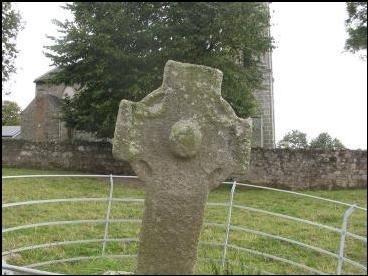
The church grounds and surrounding L-shaped field were part of a monastery. A 2001 survey showed the earliest monastic buildings date to the 5th century. The monastery here was founded by Saint Abban of Kilabban. (Medieval Monasteries Parish of Bagenalstown, Cara De v. 1, issue 3)
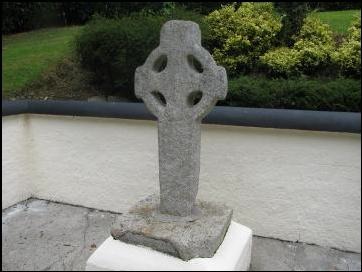
Old Leighlin, Co. Carlow: The granite cross [left] is located at Saint Laserian’s Well to the west of the present Church of Ireland. It stands 1.28 metres tall and has a pierced ring. There is no trace of any decoration. (Harbison 1992, p 161)
The monastery here was founded by Saint Gobanus, probably in the early 7th century. It became associated with Saint Laserian or Molaise. For most of its history it was a double monastery (monks and nuns). It is said to have grown across the centuries to house as many as 1500 religious. (Old Leighlin, J M. Feeley & J. Sheehan) The setting is quite lovely and obviously well maintained.
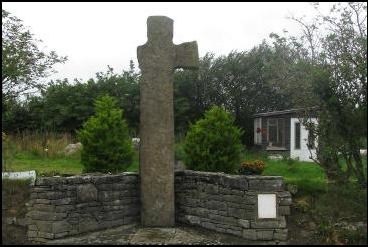
Tonaknock, Co. Kerry: The only decoration [left] seems to be small incised circles on the west head and face. It is believed to date from the 9th century. Legend says the south arm was broken by a cannon ball during the Desmond insurrection in the 16th century.
The ruins of a 7th-century church known as Tonaknock Abbey still stand. It was a collegiate church built for the Canon Regular and included a centre for the education of its priests. It continued to operate until 1600. (http://homepage.tinet.ie/~abbeydorney/book/killahan.html)
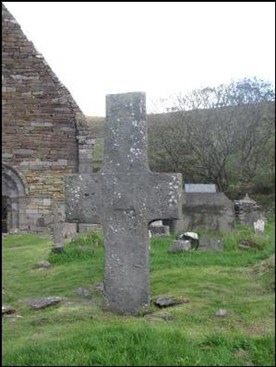
Kilmalkedar, Co. Kerry: This sandstone cross [left] is 2.5 metres tall. The only decoration is a raised square in the center of the crossing and a smaller square at the center. (Harbison 1992, p 130)
It is said the monastery at Kilmalkedar was founded by Saint Maolcethair, son of the King of Ulster, who died there in 636. He chose the site because it is near Mount Brandon, a pre-Christian religious symbol. The pilgrim’s track leading to Mount Brandon passes through Kilmalkedar.
The Kilmalkedar site is located toward the western tip of the Dingle Peninsula, near the most westerly point of Ireland. In the area there are numerous early Christian sites that date from the 5th to the 8th centuries (see below). http://www.nd.edu/~archire/sites2005/KilmalkedarMonastery2.html)
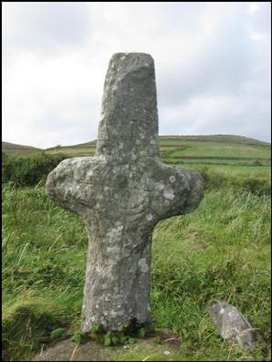
Renconnell, Co. Kerry: An incised cross and two concentric circles representing the ring on the west face. (Harbison 1992, p 162)
Renconnell is one of several other sites near Kilmalkedar. Others include the excavated site of Reask and the oratory of Gallarus. This cross is said to be in the location of an ancient cemetery. Little else is known of the history of the site.
Finding Renconnell was interesting. Peter Harbison describes it as standing in the second field in from the road. The National Monument Service provided a map that got us very close. Neighbors in the area gave us the final clues. It was not, however, until I walked across the first field and entered the second that I could see the top of the cross in the distance.
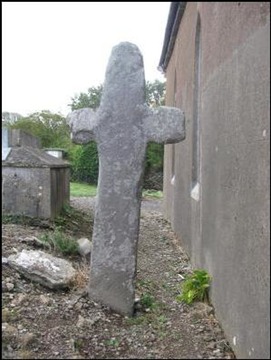
Killiney, Co. Kerry: This cross [left] stands behind the church at Killiney and very close to the south wall of the building.
Saint Enna founded a monastery here in the 7th century. (http://www.earlychristianireland.org/kerry/kerry_killiney.shtml)

Sleaty, Co. Laois: North Cross: Saint Fiacc established a monastery here in the 5th century. He is said to be a contemporary of Saint Patrick and to have composed a hymn to Patrick that is probably 7th century.
There is no sign of decoration on this cross.
(http://www.earlychristianireland.org/laois/laois_sleaty.html)

Emly, Co. Tipperary: From the Emly Parish Homepage referenced below we find this brief history of the monastery there.
“Emly is one of the oldest centres of Christianity in Ireland. We boast that it pre-dates our National Apostle, St. Patrick. Up until the early Middle Ages Emly was the seat of the premier diocese in the south of Ireland.
St. Ailbe is Patron Saint of the Archdiocese of Cashel and Emly. Tradition tells us that he preached Christianity in Munster before the arrival of St. Patrick. He is also associated with the founding of a monastery at Emly. In their book ‘The Parish of Emly’ Michael and Liam O’Dwyer write, ‘Despite the complete obliteration of the layout of the original site we may presume that the monastic enclosure coincided with the present graveyard. The presence of a well and an inscribed cross, both tradition ally associated with St. Ailbe, and the fact that successive cathedrals occupied the area near the middle of the graveyard, are sufficient evidence for this assumption.’
Emly remained a Cathedral city until the 16th century.” (http://www.emly.ie/history/)
References cited:
http://www.earlychristianireland.org/kerry/kerry_killiney.shtml
http://www.earlychristianireland.org/laois/laois_sleaty.html
http://www.nd.edu/~archire/sites2005/KilmalkedarMonastery2.html
http://www.emly.ie/history/
Henry S. Crawford’s “Descriptive List of the Early Irish Crosses”. The Journal of the Royal Society of Antiquaries of Ireland, Fifth Series, Vol, 37, o. 2. (June. 30, 1907) pp. 187-239.
Harbison, Peter; The High Crosses of Ireland: An Iconographical and Photographic Survey, Dr. Rudolf Habelt GMBH, Bonn, 1992. Volume 1: Text, Volume 2: Photographic Survey; Volume 3: Illustrations of Comparative Iconography.
http://homepage.tinet.ie/~abbeydorney/book/killahan.html
Medieval Monasteries, Parish of Bagenalstown, Cara De v. 1, issue 3 (glasnost.itcarlow.ie/~feeleyjm/monastery/nurney.pdf)
Old Leighlin, J M. Feeley & J. Sheehan (glasnost.itcarlow.ie/~feeleyjm/monastery/leighlin.pdf)